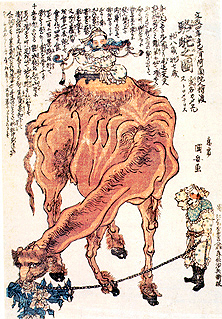

Rakuda no zu
An Insight into Misemono-e in the Late Edo Period
: Prints on Animal Shows
Yu KAWAZOE
Among many genres of ukiyo-e prints is misemono-e or show prints, which depict various kinds of sideshows and tent shows popular in the late Edo period (early modern Japan). The shows depicted in these prints are mainly categorized into three: acrobatic shows, animal shows, and craft shows such as lifelike doll shows or bamboo basketwork shows.
The quality of these Japanese sideshows and tent shows in the period was extremely high. For example, Hayatake Torakichi, a popular acrobat at the end of the Edo period had shows at various places in the United States, fascinating many American people. Shows which displayed crafts, such as Buddha images made of smelly dried fish or bamboo baskets, demonstrated the same type of wit observed in popular literature in the late Edo period. These crafts cannot be overlooked studying the entertainment culture of this period, in which abundant humor and mocks observed. Although there were many different types of sideshows and tent shows, and prints depicting them, my lecture focuses on animal shows and prints from these shows.
Just looking at animals gives us a marvelous joy. We exchange friendly greetings through our eyes with animals. In the late Edo period, many foreign animals, such as porcupines, cassowaries, camels, donkeys, elephants, leopards and tigers were imported and displayed at sideshows and tent shows. These animals became very popular among townspeople. To a certain extent, we can observe a similar fascination in people today when viewing animals such as panda bears at the zoo.
However, what was different then from today is that looking at those animals would bring some kind of fortune or good luck. They looked at the animals with an expectation as if they worshipped Buddha or God to be blessed. In the prints or flyers of those shows, the "benefits" gained by looking at those animals are listed up without fail. The benefits written there may vary from curing sickness, protection from smallpox, or gaining fortune, to chasing off seven evils and inviting seven good lucks.


Rakuda no zu
Utagawa Kuniyasu created a diptych print entitled Rakuda no zu (A camel) in 1824, depicting a show held in Uruu-August of that year in Nishi-Ryogoku, Edo (Tokyo). The following is what is written in the left one:
Camels were put up on display usually with Japanese people dressed in Chinese clothes or foreign clothes to create an exotic atmosphere. Whatever animal they were showing, it was important to create a certain foreign feeling for the show. Chinese and Western images were most preferred, but the word such as tenjiku (old term for India) and Saiho (it really means the western land, but also means the heaven in Buddhism) were also frequently used for these shows. Furthermore, the use of the names of various long-believed icons, such as Benten (the godess of fortune), Ten-nin (a heavenly being), Daikoku (the god of wealth), and Wagoshin (the god of conjugal harmony) enhanced the idea that these animals were indeed holy and would bring some lucks.
In these animal show prints, besides the urine of camels, the excrement of elephants, feathers of cassowaries, and fur of donkeys were also mentioned as medicine and charms. Show proprietors may have encouraged these ideas to lure larger audiences.
Studying these prints gives us important clues to the customes, beliefs, folklore, and psychology of the people who lived in the late Edo period.